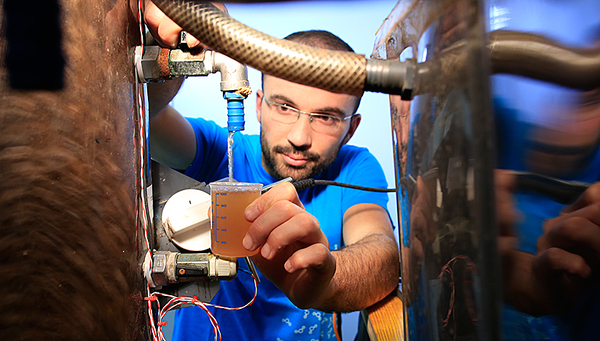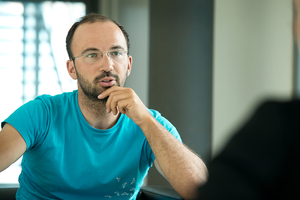News Detail
Eawag Spin-off paves the way for new wastewater treatment
August 25, 2017 |
For five years an Eawag research team worked on an affordable sanitary system in South Africa, which enables nutrients in urine to be harvested and from which fertiliser can be made. By the end of the project in 2015, this had been successfully implemented by the team under project leader Kai Udert and project coordinator Bastian Etter. In February 2016 “Aurin” recycling fertiliser was officially approved by the Federal Office for Agriculture for fertilising flowers, decorative plants and grass.
This novel form of waste-water recycling produces from a “waste product” valuable nutrients, the conventional manufacture of which requires a great deal of energy. Complicated and energy-intensive processes in wastewater treatment plants are no longer needed. It is exactly these types of unconventional solutions, with the saving of water and the meaningful use of wastewater, that the new Eawag spin-off seeks to disseminate. A discussion with CEO and environmental engineer Bastian Etter.
What services does the spin-off Vuna offer?
In Vuna we are developing concepts and solutions for wastewater and water treatment everywhere where unconventional models are needed. For example, where no connection to the regular wastewater channels is in place or where it is difficult to get water. Our tasks include concept development, planning, design and implementation, structure in other words. The system of urine processing that we worked out in Project VUNA at Eawag is exactly the type of solution that we want to develop for our future clients. Basically, it involves creating a usable product from wastewater by implementing novel solution approaches.
.. the need for unconventional solutions you have already determined during Project VUNA at Eawag?
Exactly. Toward the end of the project at Eawag we did a marketing study and found that the number of potential clients for a urine-processing installation is rather low at the moment. We noted, however, a great demand for overall systems that join water and nutrient cycles. In all, there is an ever-growing need to save water and to recover something valuable from wastewater. In addition, the present system of wastewater treatment plants is being questioned, for mixed wastewater and wastewater using drinking water must be separated in a complicated process. We want to offer our clients individual and environment-friendly alternatives.
Are there frequent cases in which conventional solutions are not practical?
More and more all the time. Classic examples are the Swiss Alpine Club huts: every hut is different; there is no standard system that can be used in every hut. Access to water and sewers is usually difficult or non-existent, which demands individual solutions different from those of our wastewater treatment plants system. This conventional system uses valuable drinking water, with which for example we flush toilets. At the other extreme is the situation in Paris, which is completely at maximum capacity with its wastewater treatment, so that it must find new and sustainable solutions.
You already have projects coming up in France and especially in Paris.
We see a really great potential in France. There are a lot of brownfield sites in Paris. Instead of simply selling these, the city government has started a competition in which one can submit bids with projects for creative and sustainable use of these buildings. The ideas it has received are extremely inspiring and future-oriented. There is, for example, an old water treatment plant in which drinking water was prepared in a huge basin from water from the Seine. This is no longer in use. In its place a housing development of modular wooden houses will be built and the basin used sustainably for fish farming and hothouses. We submitted our concept for wastewater treatment to this project. In addition, the city administration wants to test our concept for urine upgrading. In the wastewater treatment plant’s administration building, with 300 workspaces, no-mix toilets have already been installed.
What moved you to found a spin-off?
For me it has always been important that our research flows into practice. In the VUNA project we did very applicable research and developed a system that can be commercialised. In the past I occasionally consulted, but the creation of our own firm is for me personally a large field of new possibilities – and challenges!
What are your mid and long-term goals?
Our goal is clearly the further expansion of our team and our portfolio. Philippe Reymond, who is presently in Eawag’s Sandec department, will join our team in October. It is planned that he will work especially in the area of sanitation supply for developing country collaborations and humanitarian help. We want to install and operate our proven urine processing installations in as many localities as possible.
What are the greatest challenges within the spin-off?
To consolidate everything. At present the major tasks are acquisition and conceptualisation. We want to acquire and implement more projects as soon as possible. Our knowledge enables us to develop solutions that a normal engineering office would probably not consider.
Bastian Etter
Bastian Etter is a graduate of the EPFL and an environmental engineer. He has worked for about 10 years in the area of decentralised wastewater and water treatment. He has worked just as long at Eawag as member of the project STUN team in Nepal, project coordinator of the VUNA project and at present as coordinatior of the Water Hub research platform in the NEST research building. Since 2016, he has been CEO of Vuna GmbH.


